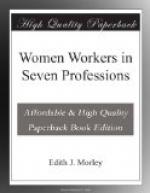The Delegacy for Oxford Local Examinations has been the first, as far as we know, to set a paper in domestic science to senior candidates. There has been a demand for it in the London Matriculation, but objection has been raised on the score of its being a smattering and a soft option. The Oxford Delegacy has introduced two new headings—Domestic Science and Hygiene—and sets two papers under each, without any practical work. The first paper is the same under both headings—Elementary Physics and Chemistry, and the preparation for this is intended to be made at least one school year before the preparation for the second paper. It should be noted that the Hygiene paper is for boys and girls; it includes a little Physiology, Personal Hygiene, and Hygiene of Buildings. The Domestic Science paper is for girls only; it has several details in common with that in Hygiene, but its main features are the simple outlines of the chemistry of foods and of cleansing substances. In a few years the suitability of these subjects for both sexes may have impressed the community.
We may notice, lastly, the arrangements made for instruction in Domestic Subjects in elementary schools.[1] This is given in a specially equipped Centre attached to a public elementary school, the girls from that and other schools attending either for a half or whole day weekly during their last two years at school. In some cases for about fifteen weeks before they leave school, girls give half the week to Domestic Subjects. This experiment has been so successful, that it is likely to be extended in the future. A carefully graded syllabus is followed; due proportion of time is given to theory and demonstration as well as to practical work. Each girl is required to do a certain amount of work by herself, and much thought has been expended in order to make the lessons as useful as possible. The care of infants and young children is receiving increased attention, and it is hoped that much may be done to mitigate evils of wrong feeding and treatment. As far as possible, the teaching in the Centres is correlated with that in the schools. Where there are science laboratories the experiments are made on food-stuffs, changes wrought by application of heat in various ways, the chemistry of common objects, and so on.
The opportunity for definite science training in connection with Domestic Subjects teaching in elementary schools is still very small, and will probably remain so while the school-leaving age is fourteen. The problem before the teacher in some instances is to combat not only an entire ignorance of the home arts, but also, in poor districts, an active experience of household mismanagement and vicious habits. The teaching in these cases has to be intensely practical, and to aim chiefly at character-building; the manual work of the subject has been found of the greatest educational value in this respect. Though the training of all Domestic Subjects’ teachers should reach the same standard of scientific knowledge, yet the actual work to be done in different types of schools is thus seen to be necessarily widely divergent in character.




